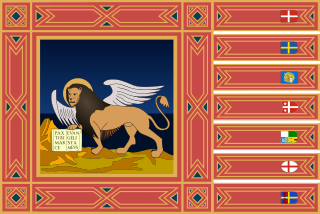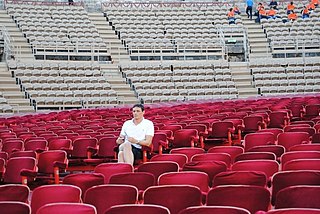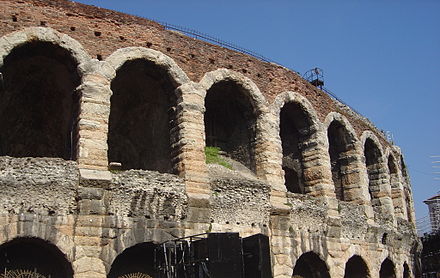
Tomaso Giovanni Albinoni was an Italian Baroque composer. His output includes operas, concertos, sonatas for one to six instruments, sinfonias, and solo cantatas. While famous in his day as an opera composer, he is known today for his instrumental music, especially his concertos. He is also remembered today for a work called "Adagio in G minor", attributed to him but said to be written by Remo Giazotto, a modern musicologist and composer, who was a cataloger of the works of Albinoni.

Veneto (, Italian: [ˈvɛːneto]; Venetian: Vèneto[ˈvɛneto] or Venetia is one of the 20 regions of Italy. Its population is about five million, ranking fifth in Italy. The region's capital is Venice.

Padua is a city and comune in Veneto, northern Italy. Padua is on the river Bacchiglione, west of Venice. It is the capital of the province of Padua. It is also the economic and communications hub of the area. Padua's population is 214,000. The city is sometimes included, with Venice and Treviso, in the Padua-Treviso-Venice Metropolitan Area (PATREVE) which has a population of around 2,600,000.

Giuseppe Tartini was an Italian Baroque composer and violinist.

Venetian or Venetan, is a Romance language spoken as a native language by Venetians, almost four million people in the northeast of Italy, mostly in the Veneto region of Italy, where most of the five million inhabitants can understand it, centered in and around Venice, which carries the prestige dialect. It is sometimes spoken and often well understood outside Veneto, in Trentino, Friuli, Venezia Giulia, Istria, and some towns of Slovenia and Dalmatia (Croatia) by a surviving autochthonous Venetian population, and Brazil, Argentina, and Mexico by Venetians in the diaspora.
The city of Venice in Italy has played an important role in the development of the music of Italy. The Venetian state—i.e. the medieval Maritime Republic of Venice—was often popularly called the "Republic of Music", and an anonymous Frenchman of the 17th century is said to have remarked that "In every home, someone is playing a musical instrument or singing. There is music everywhere."

Liga Veneta, whose complete name is Liga Veneta–Lega Nord, is a regionalist political party based in Veneto, Italy.

The Triveneto, or Tre Venezie, is a historical region of Italy. The area included what would become the three Italian regions of Venezia Euganea, Venezia Giulia and Venezia Tridentina. This territory was named after the Roman region of Venetia et Histria.
The music of Calabria is part of the Italian musical tradition. Like other regions in southern Italy, Calabria for many centuries was an integral part of the kingdom of Naples, and, as with other regions, the musical life tended to be overshadowed by the important activities in the capital city to the north—the conservatories there, the composers, the vast amount of music performed in churches. Yet, modern Calabria has developed a vibrant musical life based on its history and, as well, a dedication to building new musical and theatrical facilities, many of which are of the type termed polivalenti in Italian—that is, multi-purpose.

Venetian nationalism is a nationalist, but primarily regionalist, movement active in Veneto, Italy, as well as in other parts of the former Republic of Venice.

The Politics of Veneto, a Region of Italy takes place in a framework of a semi-presidential representative democracy, whereby the President is the head of government, and of a pluriform multi-party system. Executive power is exercised by the Regional Government. Legislative power is vested in both the government and the Regional Council.

Mauro Maur is an Italian trumpeter and composer.

Külli Tomingas, is an Estonian opera singer, mezzo-soprano, living in Milan, Italy.

Armida al campo d'Egitto is an opera in three acts by Antonio Vivaldi to a libretto by Giovanni Palazzo. It was first performed during the Carnival season of 1718 at the Teatro San Moisè in Venice. Vivaldi's version is different from the more than 50 operas whose themes derive in varying degrees from the story of Rinaldo and Armida in Torquato Tasso's epic poem La Gerusalemme liberata. Unlike the more than 50 operas based on the romance of Rinaldo and Armida, Vivaldi's version starts during previous events before the war against the Crusaders. Armida was revived for the Carnival season of 1738, with much of the music rewritten, and arias by Leonardo Leo added. Act II of the original version of the opera is now lost.

Veneto State was a Venetist political party active in Veneto and eastern Lombardy. The party's goal to achieve full political independence for the former territories of the Venetian Republic from Italy through a referendum. VS had a handful of municipal councillors and was once represented in the Regional Council of Veneto.
Ugo Orlandi is a musicologist, a specialist in the history of music, a university professor and internationally renowned mandolinist virtuoso. Among worldwide musicians, professional classical musicians are a small group; among them is an even smaller group of classical mandolinists. Among members of this group, Ugo Orlandi is considered "distinguished." Music historian Paul Sparks called him "a leading figure in the rehabilitation of the eighteenth-century mandolin repertoire, having recorded many concertos from this period."

Stefano Trespidi is an Italian opera stage director.
Cassa di Risparmio di Verona, Vicenza, Belluno e Ancona known as Cariverona in short, was an Italian savings bank headquartered in Verona. In 1991, due to Legge Amato, the bank was split into two organizations, Cassa di Risparmio di Verona, Vicenza, Belluno e Ancona S.p.A. and Fondazione Cassa di Risparmio di Verona, Vicenza, Belluno e Ancona. They joined Unicredito banking group as founding subsidiary and shareholder respectively. The banking foundation was a minority shareholder of the successor of the banking group UniCredit.
Alvise Casellati is an Italian conductor.

Minerva between Geometry and Arithmetic is a 1550 fresco fragment, usually attributed to Paolo Veronese but by some art historians to Anselmo Canera or Giambattista Zelotti. It was painted for the Palazzo de Soranzi in Castelfranco Veneto but now in the Palazzo Balbi in Venice.















